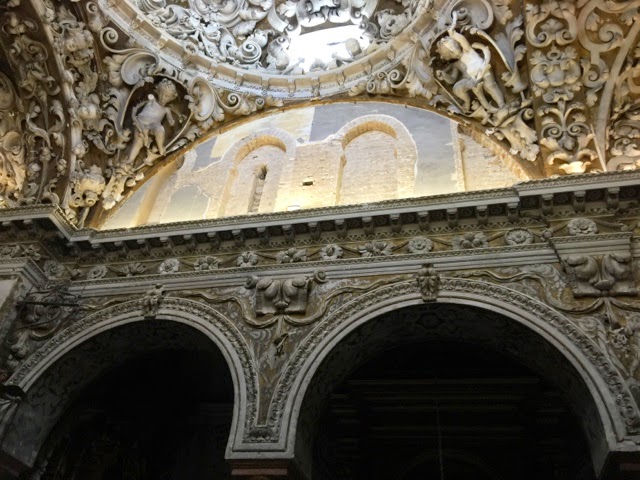Moisés Hassan takes us on a walking tour of Jewish Sevilla.
jewishsevilla.com
A church interior with יהוה misspelt but preserved on the ceiling. Though it was never a synagogue. Islamic decoration, not a Magen David
This site and some parts of this church building constituted the synagogue until 1391, when pogroms occurred. First a mosque, then synagogue, now a baroque 17th century church. Evidence of the mosque and the synagogue was discovered 3 years ago.
The baroque decoration was applied in 1660.
The exposed masonry and plaster, above, have been dated back to the 14th century.
Hotel Las Casas de la JuderiaTunnels under this hotel could be 15th century underground passages for the Conversos to secretly maintain their Jewish traditions under duress of conversion by the Spanish Inquisition.
Explore the tunnels with me in the next blogpost no 32) Tunnels under the Juderia.
Moisés Hassan
Islamic decoration, not a Magen David
This site and some parts of this church building constituted the synagogue until 1391, when pogroms occurred. First a mosque, then synagogue, now a baroque 17th century church. Evidence of the mosque and the synagogue was discovered 3 years ago.
The baroque decoration was applied in 1660.
The exposed masonry and plaster, above, have been dated back to the 14th century.
Hotel Las Casas de la Juderia
Tunnels under this hotel could be 15th century underground passages for the Conversos to secretly maintain their Jewish traditions under duress of conversion by the Spanish Inquisition.
Explore the tunnels with me in the next blogpost no 32) Tunnels under the Juderia.
Moisés Hassan
jewishsevilla.com
"Historical background
Although tradition tells us about Jews living in Seville at the time of the destruction of the first Temple (586 BCE) the presence of Jews in this city can only be verified at the time of the Visigoths (VIth-VIIth centuries). When the city was conquered by the Moslems in 712 they formed a Jewish guard for its defense; these soldiers settled in the city and its surroundings.Under the Umayyad dinasty, Seville prospered and became an important cultural center. The jews of Seville were engaged in commerce, medicine as well as the dyeing industry. Seville then became one of the four major communities in Moslem Spain. After the Berber conquest in 1013, Seville served as a refuge for jews escaping from Córdoba.
As it happened in other parts of Andalusia, the Almohade conquest in 1148 only brought death and destruction to the jews. When Seville was reconquered by the Christians in 1248, the few jews that were still in the city welcomed them with open arms. For a period of time, the Jewish community was revived and even Sevila became the second city of Castilla with the higher number of jews, only after Toledo. Gradually, as the reconquest succeeded, the Christians no longer needed money or help from the Jews, thus life became increasingly more difficult.
Soon the fate of Spanish Jewry was brutally altered. In 1378, the archdeacon of Ecija, Ferrant Martinez, launched a campaign of violent sermons against the Jews, demanding the destruction of 23 local synagogues. Though he was repeatedly ordered to stop his diatribes, Martinez succeeded in arousing passionate hatred among the masses. On the death of the archbishop in 1390, he became virtual ruler of the diocese, using this situation to intensify his anti-Jewish campaign.
A full-scale pogrom broke out on June 6, 1391. The infuriated populace attacked the Aljama from all sides, plundering and burning the houses. Many fell victims to the mob's fury, although most of the Jews accepted baptism to save their lives. At this point, the so-called “jewish problem” became the “converso problem”. As a result, the once vibrant community never recovered and, along with the other Jews of Andalusia, they were exiled in 1483, 9 years before the final expulsion."















No comments:
Post a Comment